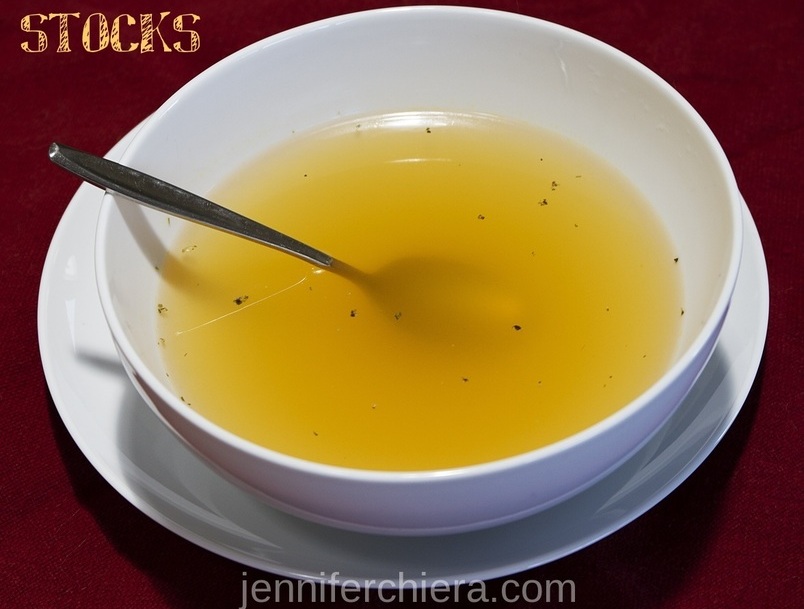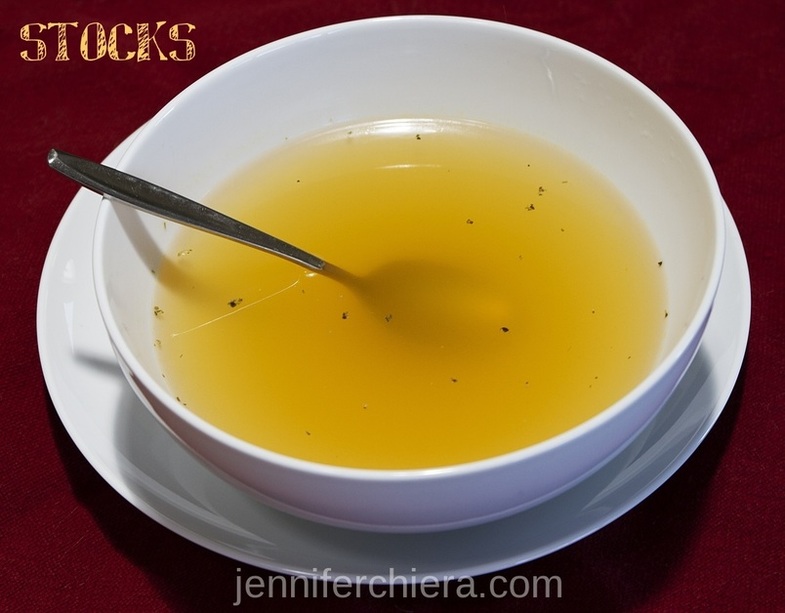
Stock, broth or bouillon is used as the basis for most soups, and in many dishes as a flavoring or base (e.g. risotto). A stock is made by cooking ingredients such as meat, poultry, fish or vegetables in water to flavor the water. The ingredients are removed at the end. Because the flavor of the ingredients is the only thing that matters, a stock is often made with left over-ingredients and by-products such as bones, that couldn’t be used elsewhere.
Stock can be made with a stock cube or extract, but for best results, make your own. If you cannot, a jar of fond (condensed stock) is the next best thing.
Vegetable Stock
This article starts with vegetable stock because most non-vegetarian stocks will use some amount of vegetables as well, to add depth to the flavor, so this information is useful for all stocks. It should be noted that, while with non-vegetarian stock, home-made is always better than stock cubes, home-made vegetable stock will often be comparable to or worse than good (vegetable) stock cubes. A home-made vegetable stock will have a relatively weak flavor, but a strong aroma.
The basic ingredients for a vegetable stock are onion, carrot, leek, and celery. It is perfectly possible to make a good stock without any of these, but they are the classic ‘backbone’ of making stock and almost all vegetable stocks will contain at least two. Other ideas for vegetables are:
tomato
bell pepper
fennel
broccoli
mushrooms
garlic
pepper
Keep the following in mind when choosing ingredients:
Potatoes absorb salt, which is the most important flavor in a stock. You can use this if your stock has become too salty. Let the potatoes cook with the stock for a while and take them out afterward.
Do not use beetroots. They will turn your stock black.
About 750 grams/26 ounces of vegetables per liter of stock should suffice.
To ’round off’ the flavor of the stock some herbs and spices are usually added. Some of these will dissolve (like peppercorns and salt), for others, it’s best to create a little ‘bag’ – for example by wrapping the herbs in a leek-leaf with a bit of string – so you can easily fish them out later. Such a bag is called a ‘bouquet garni’. Some good herbs to use are:
bay leaf (about 3 per liter of stock)
black peppercorns (about 6 per liter of stock)
salt (a pinch, you can add salt to taste later, this is essential for most stocks)
rosemary
thyme
Preparing stock is as simple as putting the ingredients in a pot (preferably large and thick, like a Dutch oven). Pouring over cold water (it needs to be cold). Bringing the water to a simmer and waiting anywhere from 30 minutes to an hour, depending on how much stock you’re making, and how strong you want it to be. Do not let vegetables simmer for more than an hour or the flavor will become wilted and sour. Some additional notes:
Do not chop your ingredients too finely. Just halve or quarter them, so the water can reach the inside of the vegetable as well as the outside.
Put the peels of onion and garlic in the stock as well. This will help with the color of the stock.
It’s a very good idea, especially with vegetable stock, to caramelize your ingredients first. This can be done by pan frying them lightly in oil or butter until they turn brown, but the oil will coat the ingredients, which will keep the water out and you’ll have to defat the stock later to get the fat out again (if you want a perfect stock). The best way to caramelize your ingredients is to put them in the oven, on a tray, until they start to brown.
The stock should be tested to see if it’s ready. When it is, pass it through a sieve to get rid of the large ingredients. If the sieved stock isn’t clear yet, put a wet tea towel in the sieve (or a cheesecloth if you have one) and pass the stock through it again. Instructions for clarifying the stock further and getting rid of the fat are given below.
Fish
Fish stock should generally be made using “white” fish bones like haddock, flounder, cod or snapper, although some Japanese recipes use tuna or similar species for a highly flavored specialized stock. Shellfish stock is generally made the same way as fish stock. Combine fish bones or shellfish shells with cold water to cover and add some diced mirepoix (carrots, celery, and onion). Bring to a simmer, skimming as necessary and simmer for 40 minutes. Strain the stock and cool it. There are many options:
Sweat (cook in hot oil and/or butter without browning, often covered) the bones or shells and mirepoix before adding the cold water. This is called fish “fumet”.
Replace part of the water with dry white wine or vintage dry cider.
Use white mirepoix (no carrots, add white part of leeks, mushroom trimmings and, optionally, parsnips)
Add aromatics such as herbs and spices (thyme, bay leaf, peppercorn, parsley stems). These may be added directly to the stock or tied in a cheesecloth (known as sachet d’epices). Add any other aromatics to impart a particular flavor.
Salt is usually necessary, add toward or at the end, to taste
Poultry
Chicken
Here’s the basic method for chicken stock, which you can adapt for different purposes.
After you’ve eaten a chicken, don’t throw away the carcass. Put it in a large saucepan, and add enough cold water to cover. Add some fresh herbs (basically, whatever is to hand, and whatever you like, but I tend to use bay leaves and sage because they’re always in the garden) maybe a roughly chopped onion, a carrot and a stick of celery, and bring to the boil slowly. Let the stock simmer very gently for as long as you can – at least three hours (but no longer than four otherwise the bones will cloud the stock and overpower the flavor). Then drain the liquid through a sieve into another pan. You can use the stock immediately, but if not, cool it as quickly as possible (stand the pan in a bowl of cold water) and refrigerate it. You can then use it within two days or so.
Pan drippings are very good to add, as long as they are not too burned.
Defatting and Clarifying
To get most of the fat out of a stock, you can simply chill it. The fat will harden and float on top of the stock where it can be scooped off easily. One can also use a fat separator, which is like a big measuring cup with a siphon from the bottom, which allows you to pour the stock out while trapping the fat.
To completely clarify stock, use the following method:
Beat egg whites to soft peaks, one for each quart/liter of stock.
Crumple the eggs-shells and mix them through the egg whites.
Stir the mixture into the stock and bring it to a simmer, do not let it boil. The egg-whites will coagulate, rise, and take any particles and cloudiness out of the stock.
Keep a close eye on the simmer (push the coagulated egg-whites to the side a bit to see) and let it simmer for about ten minutes.
Remove the pot from the heat and let it sit for another ten minutes.
Finally, sieve the stock again through a tea towel.
Fond and Consommé
A fond is made by reducing a stock down (gently, stocks shouldn’t boil) to about half of its original volume. Fonds can be used as a basis for sauces, or simply to facilitate storage, and turned in to stock again by adding water.
A consommé is made by flavoring stock again with more ingredients and condensing it greatly. Consommé is almost always made with meat. It will usually become gelatinous in substance, because of the collagen in the meat.
Storage
The stock will keep for about a week in the refrigerator. A frozen stock will keep for around six months.
Notes, Tips, and Variations
A note on terminology: Stock is the result of cooking bones, or bones with meat, with water. Broth and Bouillon are the results of cooking any food-items with water to obtain a flavored liquid. This distinction, however, is rarely made anymore, and the terms are often used interchangeably.
Though mushrooms are great for enriching a stock, it’s also possible to make the mushroom the main or even the only ingredient of a stock. For this, you would need about 200 grams/0.4 lb of mushrooms and an onion per liter of stock.


